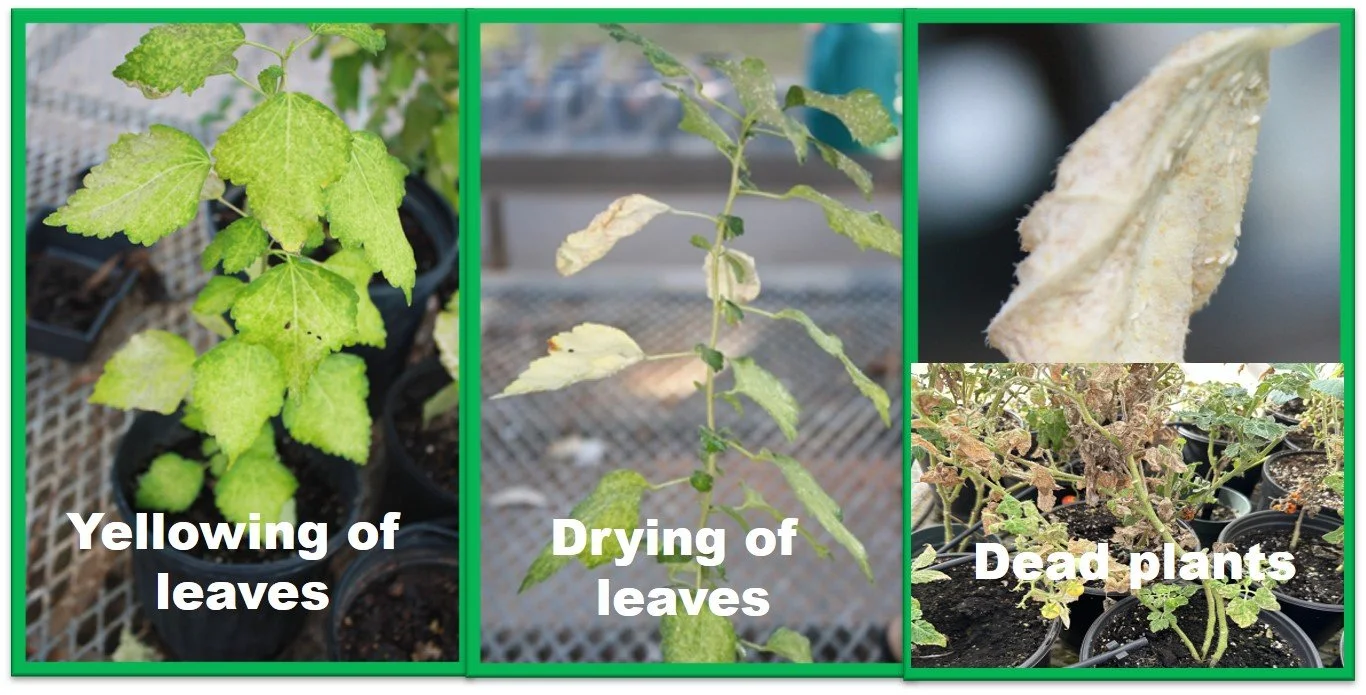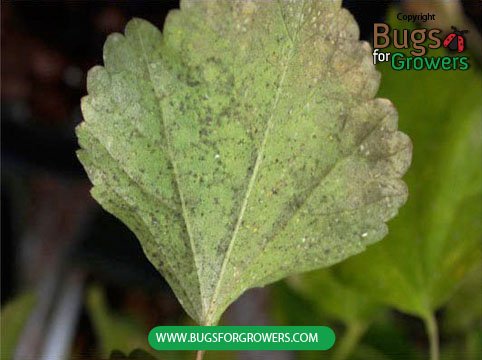Whiteflies
Greenhouse whiteflies (Trialeurodes vaporariorum) and the sweet potato whiteflies (Bemisia tabaci) pose a significant threat to greenhouse and field vegetables. They are about 2-3 mm long with soft and yellowish bodies, white wings, and piercing, sucking mouthparts. Whiteflies utilize these specialized mouthparts to extract cell sap from leaf tissues. They progress through four developmental stages: eggs, nymphs, pupae, and adults (Photo 1).
Photo 1. Developmental stages of whitefly
Damage Caused by Whiteflies
Whiteflies complete their life cycle in 3-5 weeks and generate multiple generations within a growing season. They cause both direct and indirect damage to host crops, including vegetables, ornamentals, fruits, and field crops.
Direct Damage
Direct damage occurs when adults and nymphs feed on leaf tissues, using their mouthparts to extract cell sap. Symptoms of direct damage include poor plant growth, yellowing, and drying of young leaves (Photo 2). As the damage intensifies, infested leaves dry and prematurely fall, leading to plant death.
Photo 2. Symptoms of Damage Caused by Whiteflies
Indirect Damage
Indirect damage arises from whiteflies secreting honeydew, fostering black sooty mold growth on leaves (Photo 3). The mold negatively impacts photosynthesis, diminishing the plant's ability to produce its own food. Sooty mold also reduces quality and the aesthetic appeal of ornamental plants. Additionally, whiteflies can transmit plant viruses, causing economic losses in agriculture, horticulture, and greenhouse crops.
Photo 3. Black Sooty Mold on the Underside of a Whitefly infested Leaf.
Biological Control with Beneficial Steinernema feltiae Nematodes
Beneficial nematodes like Steinernema feltiae (Photo 4) are microscopic roundworms used for biological control, targeting soil-dwelling stages of various insect pests. When they are applied to the soil surface, they need moisture for their movement in the soil, where they will locate and infect host larvae or pupae, ultimately controlling insect pests.
Photo 4. Infective Juveniles of Beneficial Steinernema feltiae nematodes
Whitefly Control With Beneficial Nematodes
In contrast to soil-dwelling stages of other insect pests, whiteflies complete their entire life cycle on aboveground plant parts such as leaves. Therefore, beneficial Steinernema feltiae nematodes should be applied to leaves and stems to control whiteflies. However, nematodes are sensitive to UV light and desiccation.
Application of Steinernema feltiae Nematodes
Recent studies have shown that using wetting agents (adjuvants) with beneficial nematodes, such as Steinernema feltiae, can enhance their survival on plant surfaces and improve their efficacy against whiteflies. This is because wetting agents protect nematodes from desiccation and UV exposure and allow them to move freely in the adjuvant solution on leaves, finding and eliminating whitefly larvae/nymphs.
To effectively use Steinernema feltiae nematodes against whiteflies, mix them with a 1% solution of horticultural oil or 0.1% Triton X-100, non-toxic substances to nematodes and humans. Make the solutions by mixing 1 part horticultural oil or 0.1 part Triton X-100 with 99 or 99.99 parts water. Thoroughly mix the nematodes in either of these solutions using a stick, adjusting the concentration as needed.
Rates of Nematode Application
Apply the nematode suspension to whitefly-infested foliage using a hand sprayer or watering can (Photo 5). Applying the nematodes at a rate of 10,000 per milliliter of the 1% horticultural oil or 0.1% Triton X-100 solutions on whitefly infested plant surfaces that can achieve over 80% whitefly control.
Photo 5. Use Watering can equipped sprinkler head for apply nematodes on plant surfaces.




